A Phase Canceling Technique to Improve SAW Duplexer Isolation
Abstract
1. Introduction
2. Duplexer and Leakage Signal
3. Phase Canceling Circuit
3.1. Principle of Phase Canceling Circuit
3.2. Structure of the Phase Shifter
3.3. Structure of Attenuator
3.4. Design
4. Results and Discussion
5. Conclusions
Author Contributions
Funding
Data Availability Statement
Conflicts of Interest
References
- Cao, W.; Li, Y.; Luo, G.Q.; Hao, Z.C.; Zhu, A. Digital Suppression of Transmitter Leakage in FDD RF Transceivers with an Enhanced Low-Sampling Rate Behavioral Model. IEEE Microw. Wirel. Compon. Lett. 2018, 28, 1140–1142. [Google Scholar] [CrossRef]
- Eslampanah, R.; Ahmed, S.; Williamson, M.; Redouté, J.M.; Faulkner, M. Adaptive Duplexing for Transceivers Supporting Aggregated Transmissions. IEEE Trans. Veh. Technol. 2016, 65, 6842–6852. [Google Scholar] [CrossRef]
- Gebhard, A.; Motz, C.; Kanumalli, R.S.; Pretl, H.; Huemer, M. Nonlinear least-mean-squares type algorithm for second-order interference cancellation in LTE-A RF transceivers. In Proceedings of the Asilomar Conference on Signals, Systems, and Computers, Pacific Grove, CA, USA, 29 October–1 November 2017; pp. 802–807. [Google Scholar]
- Goto, R.; Tang, G.; Tsurunari, T.; Nakamura, H. Modeling and Suppression of SiO2 Guided Mode on TC-SAW with a Cancelling Circuit. In Proceedings of the IEEE International Ultrasonics Symposium, Xi’an, China, 11–16 September 2021; pp. 1–4. [Google Scholar]
- Hao, D.; Wu, T.X. Design of miniaturized RF SAW duplexer package. In Proceedings of the IEEE Symposium on Ultrasonics, Honolulu, HI, USA, 5–8 October 2003; pp. 1157–1160. [Google Scholar]
- Lu, C.; Matters-Kammerer, M.K.; Zamanifekri, A.; Smolders, A.B.; Baltus, P.G.M. A Millimeter-Wave Tunable Hybrid-Transformer-Based Circular Polarization Duplexer with Sequentially-Rotated Antennas. IEEE Trans. Microwave Theory Tech. 2016, 64, 166–177. [Google Scholar] [CrossRef]
- Shiba, T.; Ooki, M.; Hamasaki, J.; Hikino, O.; Fujita, Y. 6J-2 Study of High Isolation and Miniature SAW Duplexer. In Proceedings of the IEEE Ultrasonics Symposium, Vancouver, BC, Canada, 2–6 October 2006; pp. 1060–1064. [Google Scholar]
- Tsutsumi, J.; Matsumoto, K. Impact of super-isolation duplexer on SAW-less receiver RF front-end for cellular phones. In Proceedings of the European Microwave Conference, Rome, Italy, 29 September–1 October 2009; pp. 322–325. [Google Scholar]
- Tsutsumi, J.; Inoue, S.; Iwaki, M.; Hara, M.; Nakamura, H.; Matsumoto, K. A design technique to enhance isolation of duplexer in single-ended and differential modes. In Proceedings of the IEEE International Ultrasonics Symposium, Orlando, FL, USA, 18–21 October 2011; pp. 1833–1836. [Google Scholar]
- Tsutsumi, J.; Matsumoto, K. Super-Isolation Duplexer Aiming for Removing Rx Inter-stage Filter in W-CDMA Handsets. In Proceedings of the European Microwave Conference, Amsterdam, The Netherlands, 27–31 October 2008; pp. 1066–1069. [Google Scholar]
- Iwaki, M.; Tsutsumi, J.; Endo, Y.; Nakamura, H.; Satoh, Y. An attenuation improvement technology for ladder SAW/FBAR filters and duplexers employing cancellation circuit. In Proceedings of the European Microwave Conference, Manchester, UK, 10–13 October 2011; pp. 751–754. [Google Scholar]
- Devaskar, A.R.; Agarwal, V.; Kulkarni, V. Design and Simulation of Band 40 RF SAW Ladder-Type Filter. In Proceedings of the IEEE International Conference on Semiconductor Electronics, Kuala Lumpur, Malaysia, 15–17 August 2022; pp. 53–56. [Google Scholar]
- Li, C.Y.; Hsu, H.J.; Chen, L.S.; Houng, M.P. Investigation of characteristics of dual-band ladder-type surface acoustic wave for high-power durability duplexer. Sens. Mater. 2019, 31, 261. [Google Scholar] [CrossRef]
- Hashimoto, K.-y.; Omori, T.; Yamaguchi, M. Operation Mechanism of Double-Mode Surface Acoustic Wave Filters with Pitch-Modulated IDTs and Reflectors. IEEE Trans. Ultrason. Ferroelect. Freq. Contr. 2007, 54, 2152–2158. [Google Scholar] [CrossRef] [PubMed]
- Alrabadi, O.N.; Tatomirescu, A.D.; Knudsen, M.B.; Pelosi, M.; Pedersen, G.F. Breaking the Transmitter–Receiver Isolation Barrier in Mobile Handsets with Spatial Duplexing. IEEE Trans. Antennas Propagat. 2013, 61, 2241–2251. [Google Scholar] [CrossRef]
- Frotzscher, A.; Fettweis, G. Baseband analysis of Tx leakage in WCDMA Zero-IF-receivers. In Proceedings of the International Symposium on Communications, Control and Signal Processing, Saint Julian’s, Malta, 12–14 March 2008; pp. 129–134. [Google Scholar]
- Gebhard, A.; Lunglmayr, M.; Motz, C.; Kanumalli, R.S.; Auer, C.; Paireder, T.; Wagner, M.; Pretl, H.; Huemer, M. A Robust Nonlinear RLS Type Adaptive Filter for Second-Order-Intermodulation Distortion Cancellation in FDD LTE and 5G Direct Conversion Transceivers. IEEE Trans. Microwave Theory Tech. 2019, 67, 1946–1961. [Google Scholar] [CrossRef]
- Kiayani, A.; Anttila, L.; Valkama, M. Active RF cancellation of nonlinear TX leakage in FDD transceivers. In Proceedings of the IEEE Global Conference on Signal and Information Processing, Washington, DC, USA, 7–9 December 2016; pp. 689–693. [Google Scholar]
- Hashimoto, K.; Omori, T.; Yamaguchi, M. Design considerations on surface acoustic wave resonators with significant internal reflection in interdigital transducers. IEEE Trans. Ultrason. Ferroelect. Freq. Contr. 2004, 51, 1394–1403. [Google Scholar] [CrossRef] [PubMed]
- Hashimoto, K.; Omori, T.; Yamaguchi, M. Design considerations on wideband longitudinally-coupled double-mode SAW filters. In Proceedings of the IEEE Ultrasonics Symposium, Munich, Germany, 8–11 October 2002; pp. 153–157. [Google Scholar]
- Hasegawa, K.; Inagawa, K.; Koshiba, M. Coefficients of Coupled-Mode Equations for Reversal of Directivity Transducers on a 50°Y-25°X La3Ga5SiO14 Substrate. Jpn. J. Appl. Phys. 2001, 40, 3751. [Google Scholar] [CrossRef]
- Lehtonen, S.; Plessky, V.P.; Bereux, N.; Salomaa, M.M. Phases of the SAW reflection and transmission coefficients for short reflectors on 128 degree LiNbO. IEEE Trans. Ultrason. Ferroelect. Freq. Contr 2004, 51, 1671–1682. [Google Scholar] [CrossRef] [PubMed]
- Kimura, N.; Takeuchi, M. A Design of Surface Acoustic Wave Wideband Single-Phase-Unidirectional Transducers Using Coupling-of-Modes Theory. Jpn. J. Appl. Phys. 1999, 38, 3265. [Google Scholar] [CrossRef]
- Ro, R.; Tung, H.Y.; Wu, S.J. Design of Two-Track Surface Acoustic Wave Filters with Width-Controlled Reflectors. Jpn. J. Appl. Phys. 2004, 43, 688–694. [Google Scholar] [CrossRef]
- Casares-Miranda, F.P.; Otero, P.; Marquez-Segura, E.; Camacho-Penalosa, C. Wire bonded interdigital capacitor. IEEE Microw. Wirel. Compon. Lett. 2005, 15, 700–702. [Google Scholar] [CrossRef]
- Angkawisittpan, N.; Manasri, T. Determination of sugar content in sugar solutions using interdigital capacitor sensor. Meas. Sci. Rev. 2013, 12, 8–13. [Google Scholar] [CrossRef]

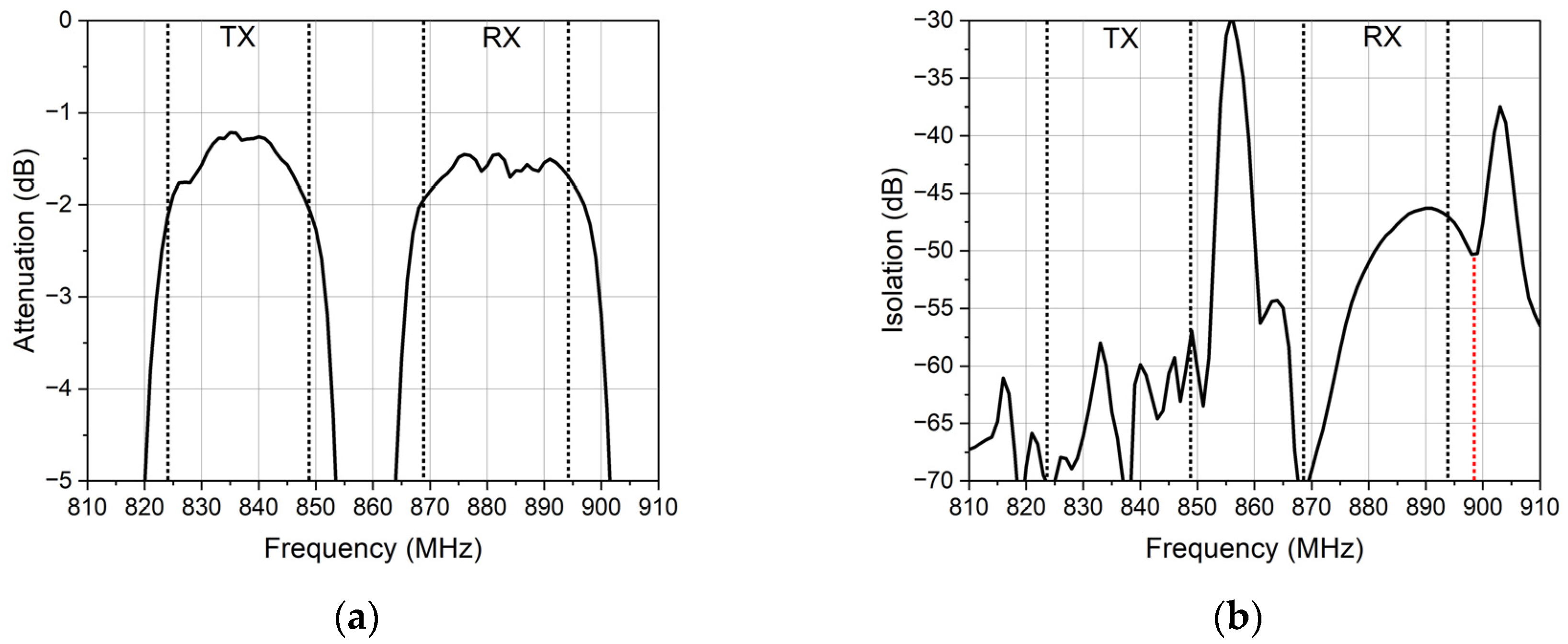
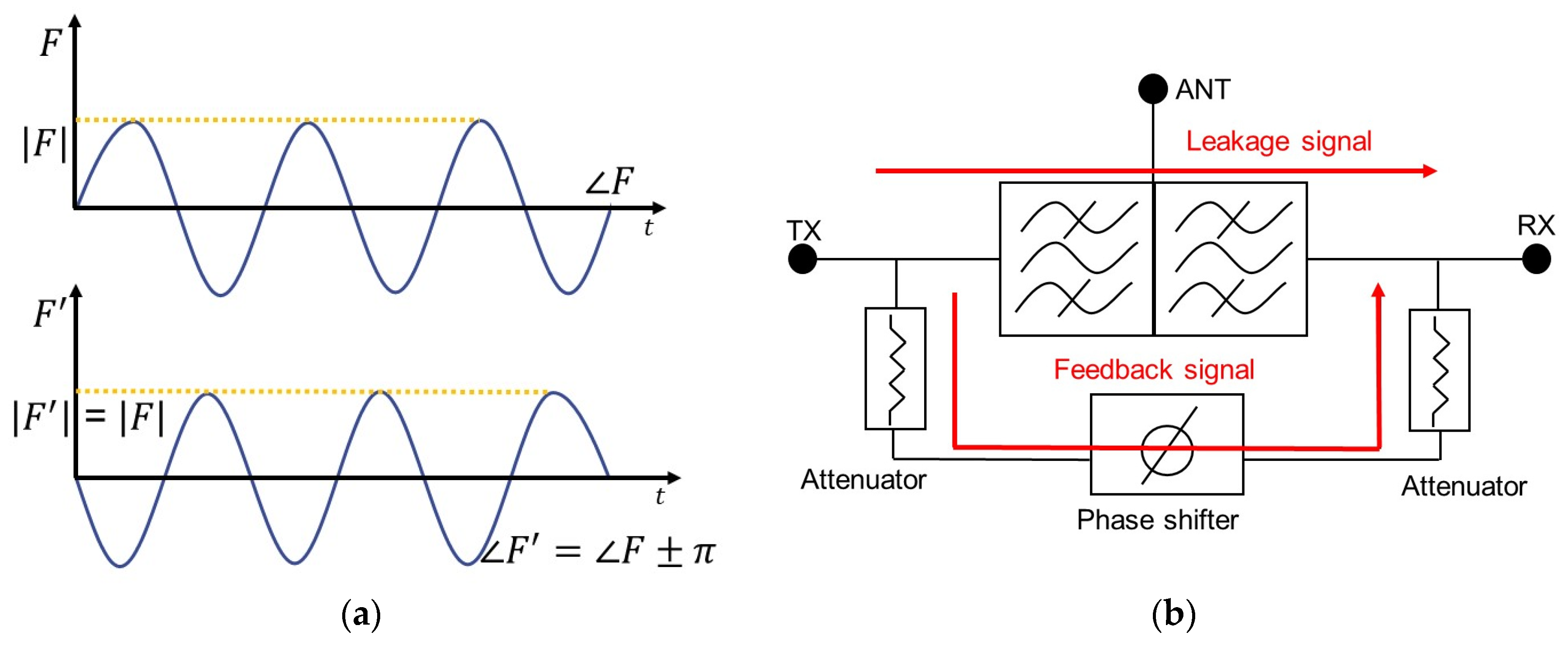

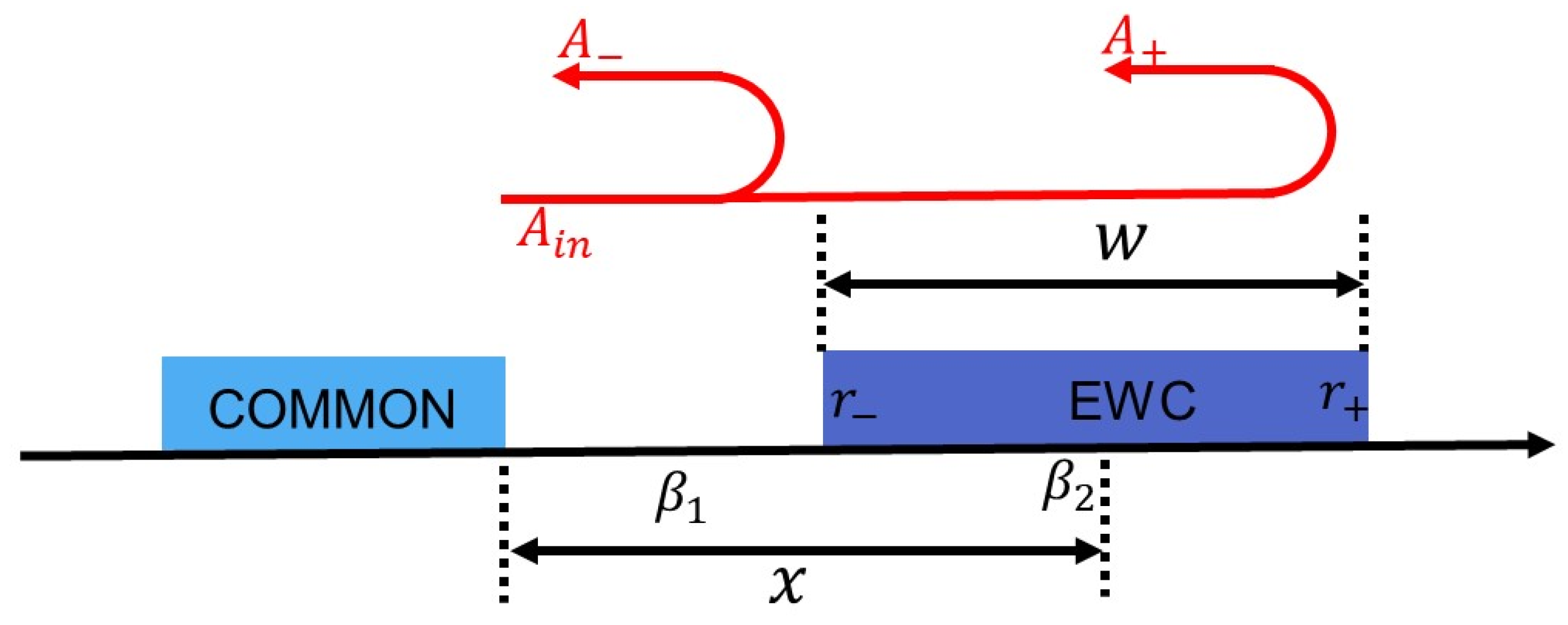



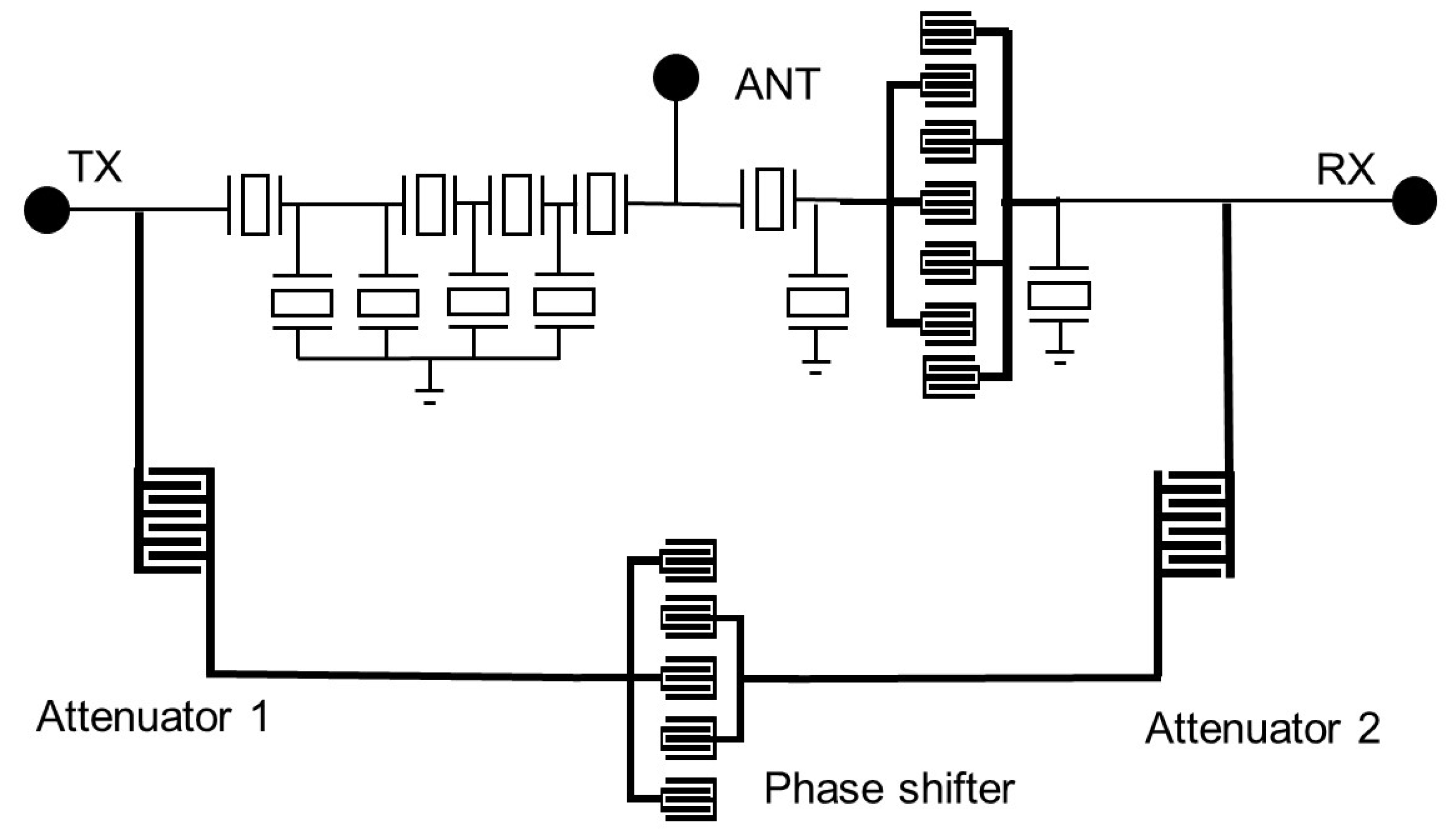
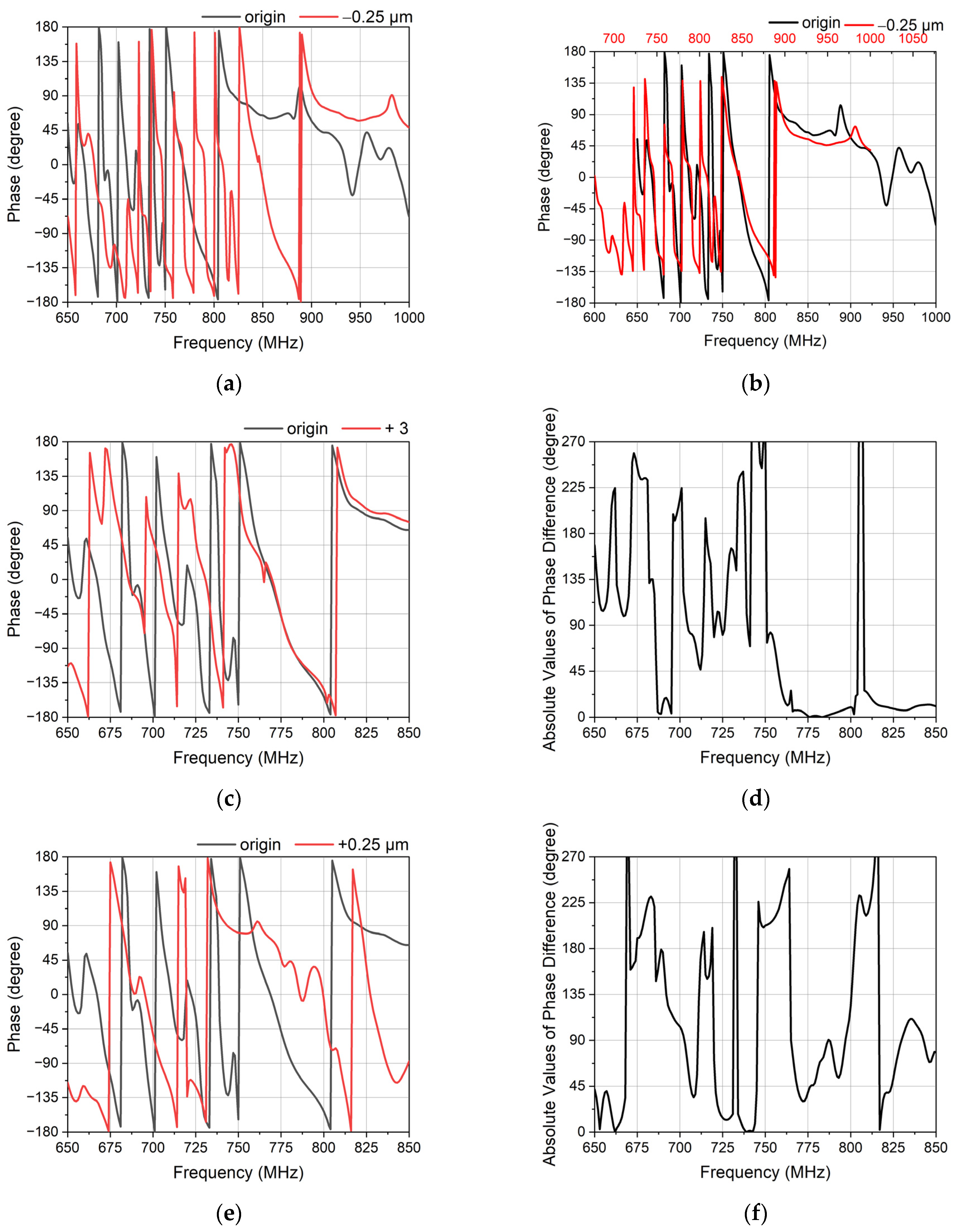
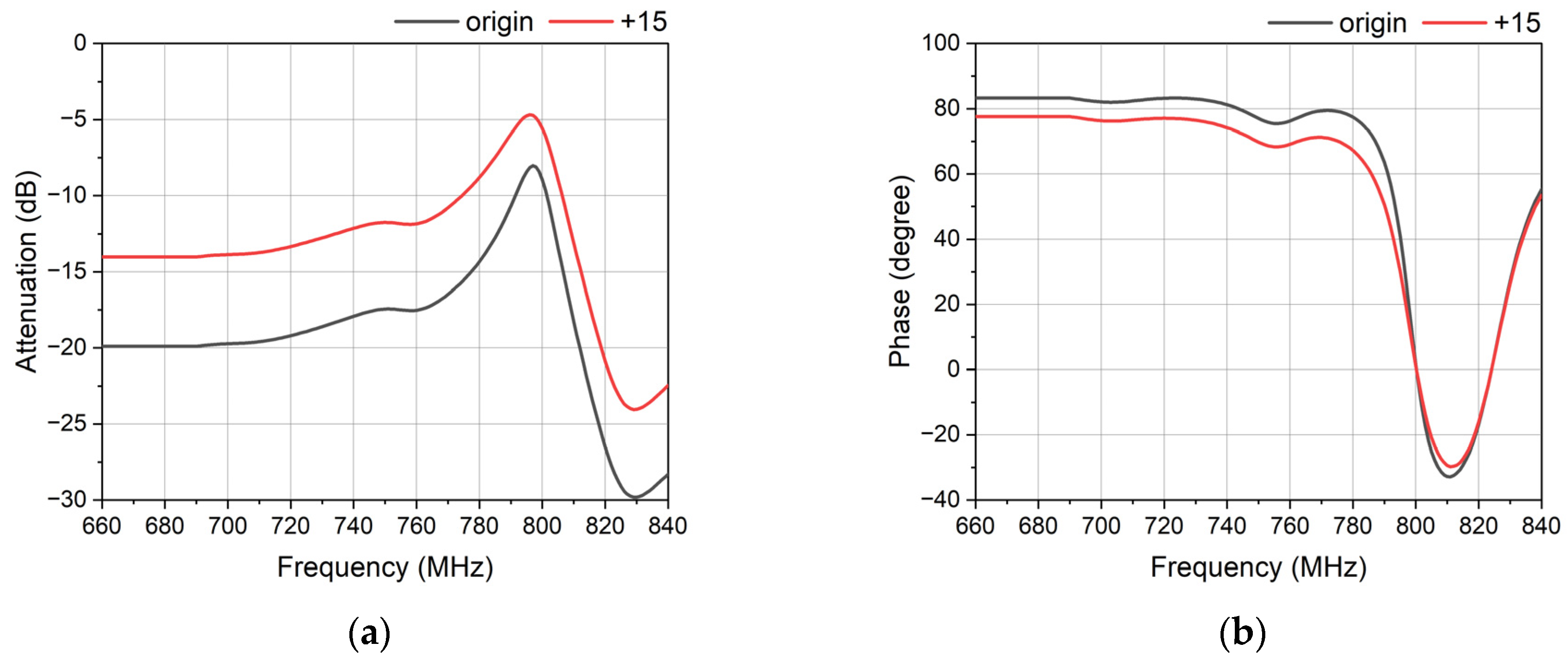
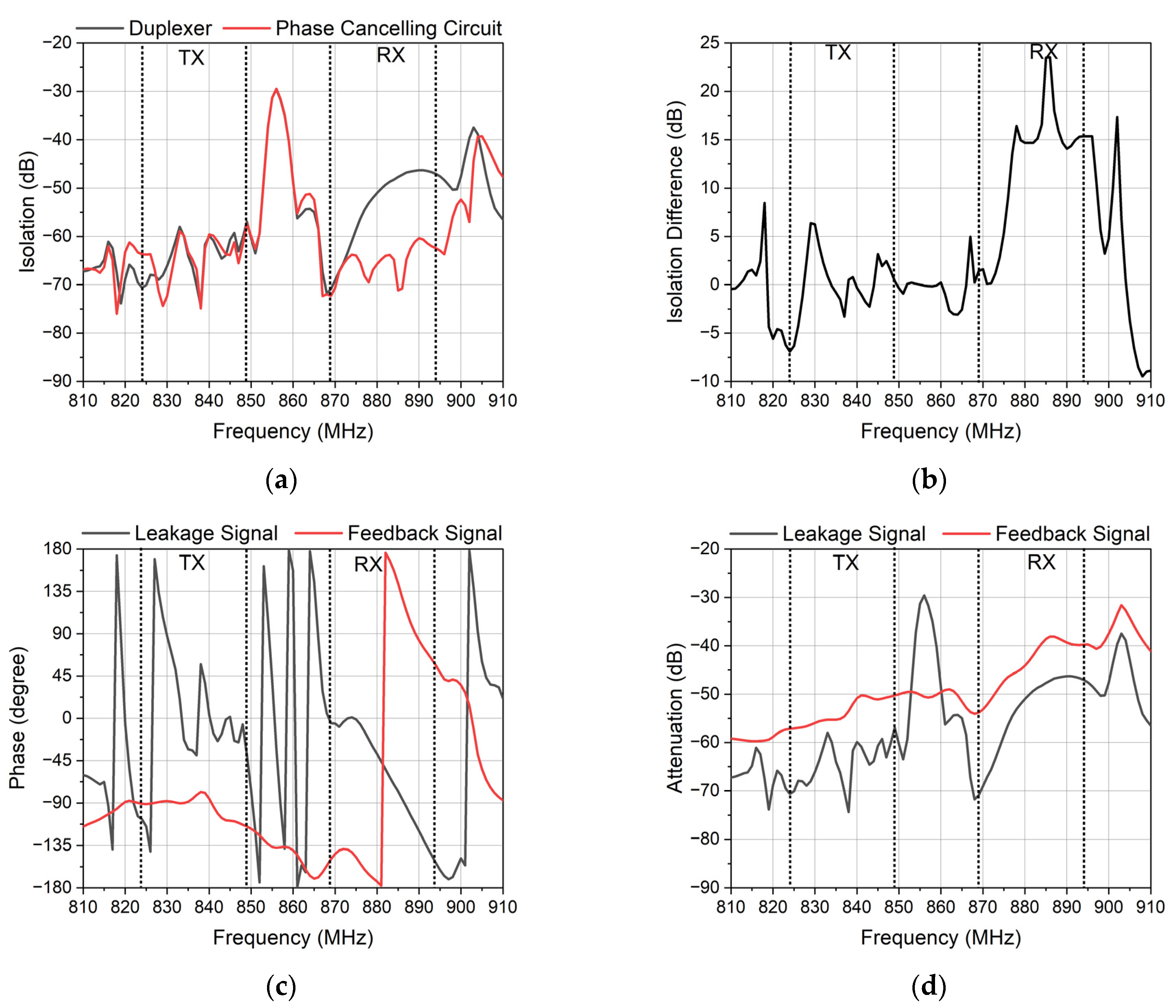
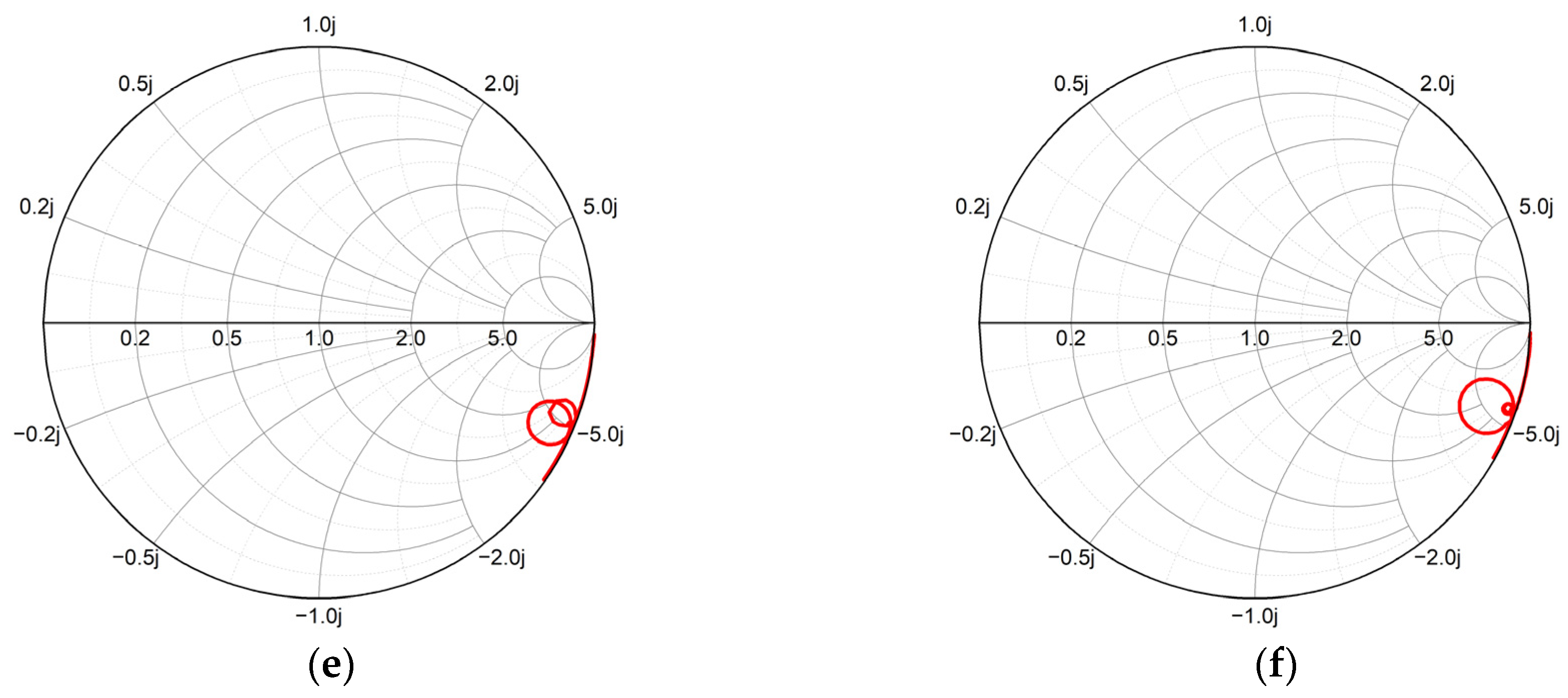
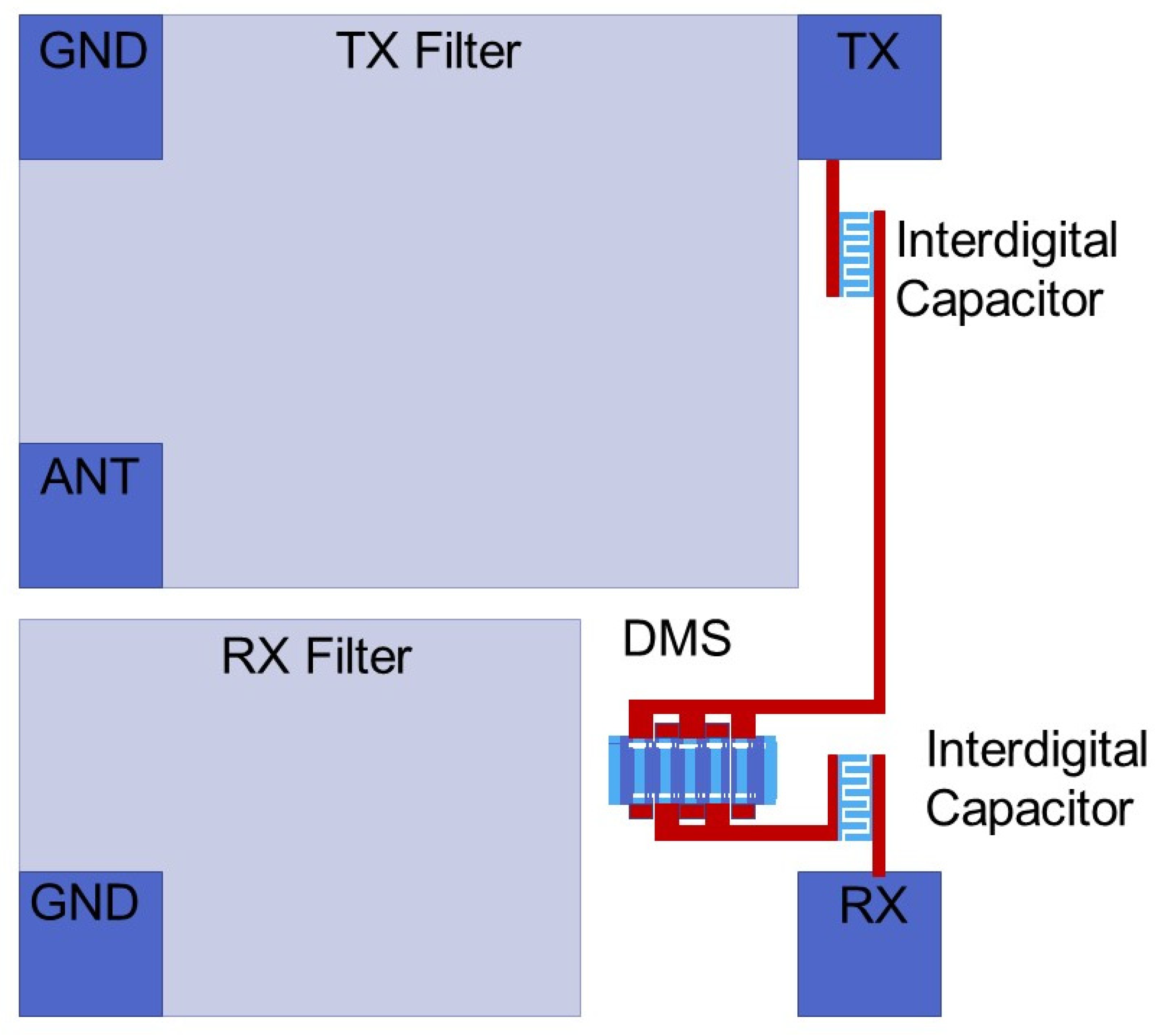
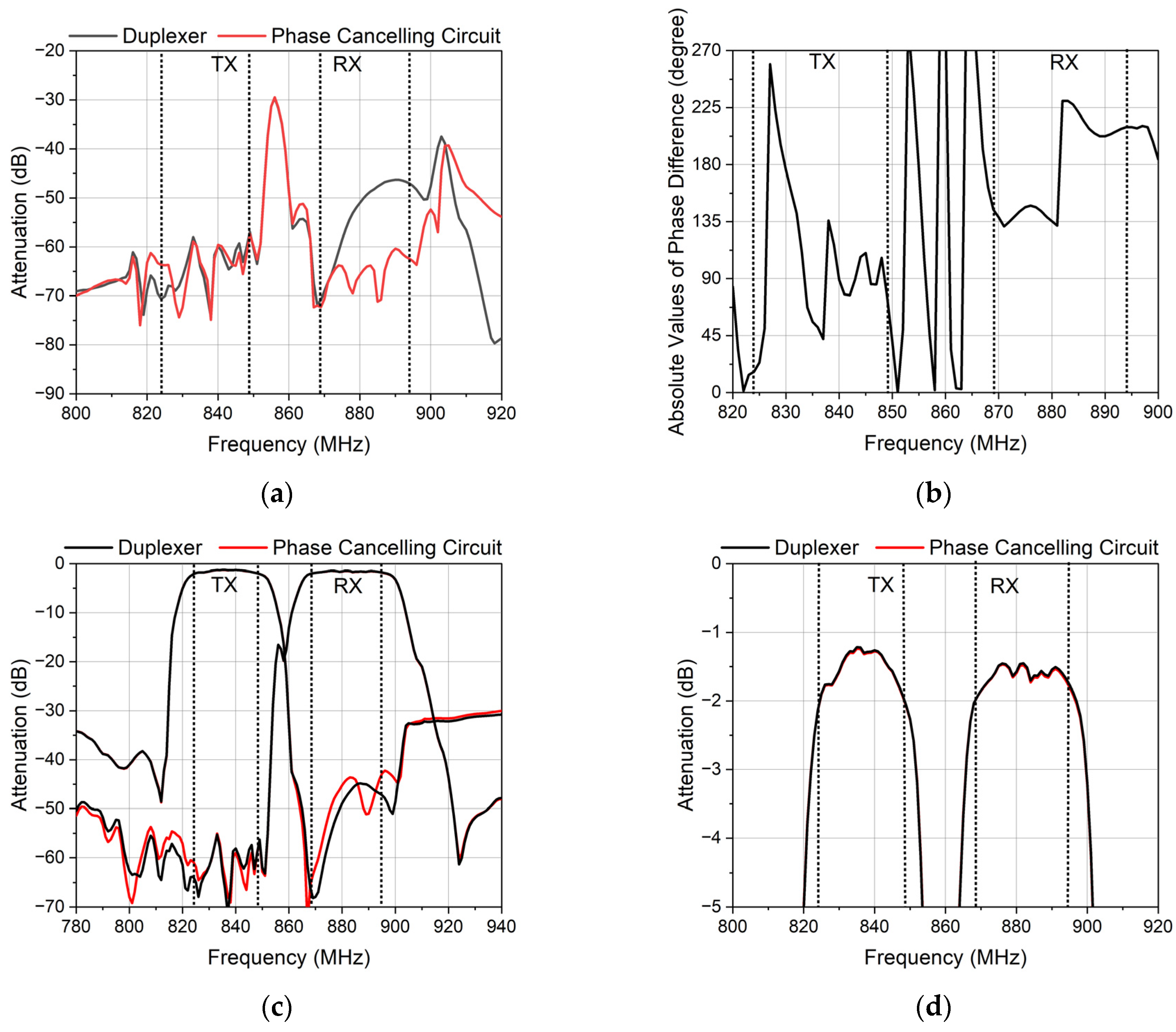
| Parameters | Values | |||||
|---|---|---|---|---|---|---|
| 1 | 2 | 3 | 4 | 5 | ||
| DMS_IDT | n_idt | 8 | 15 | 28 | 20 | 8 |
| width | 1.16 | 1.16 | 1.224 | 1.172 | 1.172 | |
| N_L | 3 | 3 | 3 | 3 | 2 | |
| w_EWC_L | 1.279 | 1.279 | 1.304 | 1.038 | 1.038 | |
| N_R | 0 | 0 | 4 | 2 | 4 | |
| w_EWC_R | 0 | 0 | 1.317 | 1.304 | 1.304 | |
| DMS_REF | n_ref | 5 | 5 | |||
| w_ref | 1.182 | 1.182 | ||||
| N_ref | 3 | 1 | ||||
| w_ref_EWC | 1.172 | 1.113 | ||||
| Capacitor | Nc | 29 | 29 | |||
| width | 1 | 1 | ||||
| l | 15 | 15 | ||||
Disclaimer/Publisher’s Note: The statements, opinions and data contained in all publications are solely those of the individual author(s) and contributor(s) and not of MDPI and/or the editor(s). MDPI and/or the editor(s) disclaim responsibility for any injury to people or property resulting from any ideas, methods, instructions or products referred to in the content. |
© 2023 by the authors. Licensee MDPI, Basel, Switzerland. This article is an open access article distributed under the terms and conditions of the Creative Commons Attribution (CC BY) license (https://creativecommons.org/licenses/by/4.0/).
Share and Cite
Tao, J.; Tang, Z.; Zou, Y.; Wang, B.; Li, J.; Liu, Y.; Wu, T. A Phase Canceling Technique to Improve SAW Duplexer Isolation. Micromachines 2023, 14, 239. https://doi.org/10.3390/mi14020239
Tao J, Tang Z, Zou Y, Wang B, Li J, Liu Y, Wu T. A Phase Canceling Technique to Improve SAW Duplexer Isolation. Micromachines. 2023; 14(2):239. https://doi.org/10.3390/mi14020239
Chicago/Turabian StyleTao, Jianbin, Zhengjie Tang, Yali Zou, Bin Wang, Jiawei Li, Yuhao Liu, and Tao Wu. 2023. "A Phase Canceling Technique to Improve SAW Duplexer Isolation" Micromachines 14, no. 2: 239. https://doi.org/10.3390/mi14020239
APA StyleTao, J., Tang, Z., Zou, Y., Wang, B., Li, J., Liu, Y., & Wu, T. (2023). A Phase Canceling Technique to Improve SAW Duplexer Isolation. Micromachines, 14(2), 239. https://doi.org/10.3390/mi14020239






